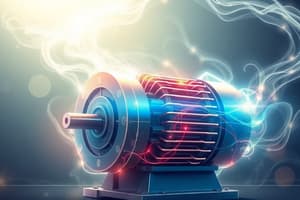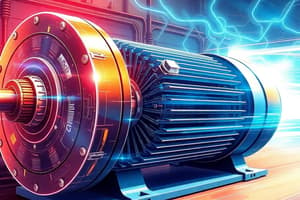Podcast
Questions and Answers
What is the purpose of the external resistances in the rotor circuit of a wound-rotor induction motor?
What is the purpose of the external resistances in the rotor circuit of a wound-rotor induction motor?
- To increase the efficiency of the motor
- To decrease the starting current
- To increase the starting torque (correct)
- To provide a braking force
What is the relationship between the number of poles (P) in a three-phase induction motor and the synchronous speed (Ns)?
What is the relationship between the number of poles (P) in a three-phase induction motor and the synchronous speed (Ns)?
- Ns is directly proportional to the square of P
- Ns is inversely proportional to the square of P
- Ns is inversely proportional to P (correct)
- Ns is directly proportional to P
What is the synchronous speed (Ns) of a four-pole induction motor operating at a frequency of 50 Hz?
What is the synchronous speed (Ns) of a four-pole induction motor operating at a frequency of 50 Hz?
- 1500 rpm (correct)
- 750 rpm
- 3000 rpm
- 1000 rpm
What is the function of the slip rings in a wound-rotor induction motor?
What is the function of the slip rings in a wound-rotor induction motor?
What is the significance of the laminated cylindrical core in the rotor of a wound-rotor induction motor?
What is the significance of the laminated cylindrical core in the rotor of a wound-rotor induction motor?
What is the formula for the synchronous speed (Ns) of a three-phase induction motor?
What is the formula for the synchronous speed (Ns) of a three-phase induction motor?
Which of the following is NOT a factor that determines the synchronous speed of a three-phase induction motor?
Which of the following is NOT a factor that determines the synchronous speed of a three-phase induction motor?
What is the primary function of the rotating magnetic field in a three-phase induction motor?
What is the primary function of the rotating magnetic field in a three-phase induction motor?
What is the relationship between the rotating magnetic field's direction and the rotor's direction of motion?
What is the relationship between the rotating magnetic field's direction and the rotor's direction of motion?
Why are currents induced in the rotor conductors of a three-phase induction motor?
Why are currents induced in the rotor conductors of a three-phase induction motor?
How does Lenz's law explain the movement of the rotor in a three-phase induction motor?
How does Lenz's law explain the movement of the rotor in a three-phase induction motor?
What is the purpose of short-circuiting the rotor windings in a three-phase induction motor?
What is the purpose of short-circuiting the rotor windings in a three-phase induction motor?
What is the primary difference between a three-phase induction motor and a synchronous motor?
What is the primary difference between a three-phase induction motor and a synchronous motor?
What is the relationship between the frequency of the rotor current (fr) and the slip (s)?
What is the relationship between the frequency of the rotor current (fr) and the slip (s)?
What is the frequency of the rotor current when the rotor is at standstill?
What is the frequency of the rotor current when the rotor is at standstill?
What is the formula for calculating the slip?
What is the formula for calculating the slip?
A 4-pole induction motor is connected to a 50 Hz supply. What is the synchronous speed of the motor?
A 4-pole induction motor is connected to a 50 Hz supply. What is the synchronous speed of the motor?
A 6-pole induction motor operates at a slip of 5%. What is the rotor speed?
A 6-pole induction motor operates at a slip of 5%. What is the rotor speed?
An induction motor is connected to a 60 Hz supply. The motor has 8 poles and rotates at 850 rpm. What is the slip of the motor?
An induction motor is connected to a 60 Hz supply. The motor has 8 poles and rotates at 850 rpm. What is the slip of the motor?
What is the main reason why three-phase induction motors are widely used in industries?
What is the main reason why three-phase induction motors are widely used in industries?
Why does the rotor of an induction motor try to catch up with the stator field?
Why does the rotor of an induction motor try to catch up with the stator field?
What is the primary function of the rotor winding in a three-phase induction motor?
What is the primary function of the rotor winding in a three-phase induction motor?
What happens to the frequency of the rotor current as the slip decreases?
What happens to the frequency of the rotor current as the slip decreases?
What is the purpose of using laminated silicon steel for the core of the stator in a three-phase induction motor?
What is the purpose of using laminated silicon steel for the core of the stator in a three-phase induction motor?
What is the key difference between a squirrel-cage rotor and a wound rotor in a three-phase induction motor?
What is the key difference between a squirrel-cage rotor and a wound rotor in a three-phase induction motor?
What is the primary advantage of using a three-phase induction motor over a direct current (DC) shunt motor?
What is the primary advantage of using a three-phase induction motor over a direct current (DC) shunt motor?
Which of the following is NOT a disadvantage of a three-phase induction motor?
Which of the following is NOT a disadvantage of a three-phase induction motor?
What is the purpose of the air gap between the stator and rotor in a three-phase induction motor?
What is the purpose of the air gap between the stator and rotor in a three-phase induction motor?
What is the primary function of the end rings in a squirrel-cage rotor?
What is the primary function of the end rings in a squirrel-cage rotor?
Flashcards
Three-Phase Induction Motor
Three-Phase Induction Motor
An electric motor widely used in industries, operating at constant speed under load.
Stator
Stator
The stationary part of a three-phase induction motor, housing the stator winding.
Rotor
Rotor
The rotating part of the induction motor that carries the rotor winding.
Air Gap
Air Gap
Signup and view all the flashcards
Squirrel Cage Rotor
Squirrel Cage Rotor
Signup and view all the flashcards
Wound Rotor
Wound Rotor
Signup and view all the flashcards
Advantages of Induction Motors
Advantages of Induction Motors
Signup and view all the flashcards
Disadvantages of Induction Motors
Disadvantages of Induction Motors
Signup and view all the flashcards
Wound type induction motor
Wound type induction motor
Signup and view all the flashcards
Synchronous speed (Ns)
Synchronous speed (Ns)
Signup and view all the flashcards
Star-connected rotor winding
Star-connected rotor winding
Signup and view all the flashcards
Starting torque
Starting torque
Signup and view all the flashcards
Slip rings
Slip rings
Signup and view all the flashcards
Rotor Direction
Rotor Direction
Signup and view all the flashcards
Slip
Slip
Signup and view all the flashcards
Frequency of Rotor Current
Frequency of Rotor Current
Signup and view all the flashcards
Standstill Condition
Standstill Condition
Signup and view all the flashcards
Increased Rotor Speed
Increased Rotor Speed
Signup and view all the flashcards
Slip Calculation
Slip Calculation
Signup and view all the flashcards
Rotor Frequency (fr)
Rotor Frequency (fr)
Signup and view all the flashcards
Resultant Flux
Resultant Flux
Signup and view all the flashcards
Rotating Magnetic Field
Rotating Magnetic Field
Signup and view all the flashcards
Induced e.m.f.
Induced e.m.f.
Signup and view all the flashcards
Torque
Torque
Signup and view all the flashcards
Lenz's Law
Lenz's Law
Signup and view all the flashcards
Stationary Rotor
Stationary Rotor
Signup and view all the flashcards
Mechanical Force
Mechanical Force
Signup and view all the flashcards
Study Notes
AC Electrical Machines: Three-Phase Induction Motor
- Three-phase induction motors are the most common type of electric motor used in industry.
- They maintain a relatively constant speed from no load to full load.
- The motor consists of a stator and a rotor.
- The stator houses a three-phase winding (stator winding).
- The rotor has a short-circuited winding (rotor winding).
- The machine converts electrical energy into mechanical energy.
Advantages
- Simple and rugged construction
- Relatively inexpensive
- Low maintenance requirements
- High efficiency
- Good power factor
- Self-starting torque
Disadvantages
- Constant speed characteristic - Changing speed is difficult.
- Lower starting torque compared to DC shunt motors.
Construction: Stator
- A steel frame encloses a hollow cylindrical core.
- The core is made of thin, laminated silicon steel to minimize hysteresis and eddy current losses.
- Slots in the core house the stator windings.
Construction: Rotor
- Squirrel Cage Type:
- Consists of a cylindrical laminated core with parallel slots.
- Copper or aluminum bars are placed within each slot.
- The bars are shorted together at each end by end rings.
- This forms a permanently short-circuited winding.
- Wound Type:
- Has a laminated cylindrical core.
- The core carries a three-phase winding similar to the stator winding.
- The rotor winding terminals are connected to slip rings mounted on the rotor shaft.
- External resistance is incorporated in the rotor circuit during starting to increase torque.
- Gradually reduced as the motor accelerates to reach rated speed.
Speed of Rotating Magnetic Field
- The speed at which the magnetic field rotates is called synchronous speed (Ns).
- For a P-pole motor, with a frequency (f) of the supply current, the synchronous speed is calculated by this formula: Ns = (120 × f) / P
Slip
- The difference between the synchronous speed (Ns) and the actual rotor speed (N) is called slip (s).
- Slip is usually expressed as a percentage of synchronous speed. s = [(Ns - N) / Ns] × 100
- Slip is typically small (0.1% to 3%) in induction motors.
Frequency of Rotor Current
- At standstill (s = 1), the rotor frequency (fr) is the same as the supply frequency (f).
- When the rotor rotates, the rotor frequency is related to the slip and supply frequency by the following equation: fr = s × f
Studying That Suits You
Use AI to generate personalized quizzes and flashcards to suit your learning preferences.





